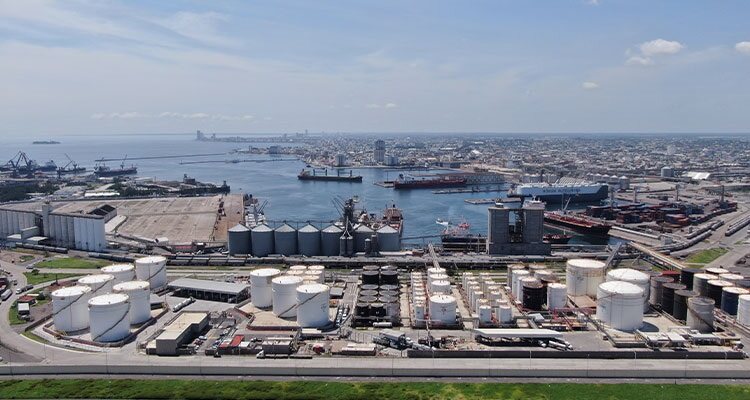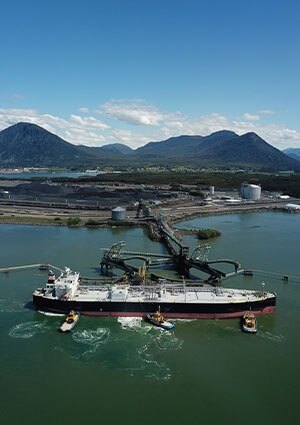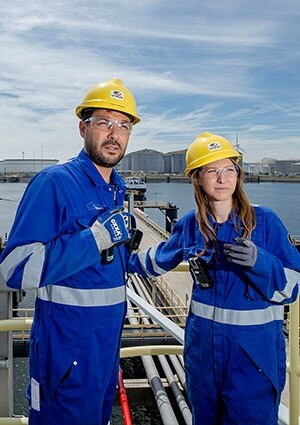
Vopak Americas has been keeping the region’s vital products safe and secure for over 400 years
Vopak is an independent infrastructure provider with an unrivalled network of 78 terminals in 23 countries and more than 25 joint venture partners around the globe. It connects and supplies products that are not only essential to several economies, but also vital to people’s everyday lives.
As the global population continues to rise, so does the demand for vital products like food, energy, and chemicals. With the added focus of the global transition to renewable energy, Vopak is working to improve access to cleaner energy and feedstocks. It is developing infrastructure solutions for new products, such as zero and low carbon hydrogen and ammonia, in addition to biofuels and recycled chemicals.
In the Americas, Vopak is the region’s leading provider of storage terminal facilities, with a total of over five million cubic meters of storage capacity across the US, Canada, Mexico, Panama, Brazil, Colombia, and Venezuela. We sit down with Maria Ciliberti, Vopak President USA & Canada, to discuss America’s green energy transition and the company’s latest projects, including a major joint venture in Canada.
 “We have a rich, 400-year history and have evolved over many centuries, which is testament to our stability, but also our ability to adapt,” Maria begins. “We continually assess the business and adjust to market needs, ensuring that our product portfolio always meets the requirements and expectations of our customers.
“We have a rich, 400-year history and have evolved over many centuries, which is testament to our stability, but also our ability to adapt,” Maria begins. “We continually assess the business and adjust to market needs, ensuring that our product portfolio always meets the requirements and expectations of our customers.
Storing with care
“North America requires a more intense, specific focus in the near future, as there are many opportunities coming to market, particularly in the US with the Inflation Reduction Act (IRA), and we adjusted our organization to this,” Maria explains. “It’s another example of our ability to be responsive to market changes, which is going to be crucial as the energy transition develops further.
“Although there are several processes and infrastructures involved in our success, I believe the key is our leadership,” she states. “We have committed leaders who recognize the need to adapt, which has enabled us to sustain our position as a quality service provider that stores vital products with care. It’s given us stability, but also the capability to assess and respond to changes in the marketplace.”
Vopak’s work touches on supporting the oil, gas, and chemical industries; this includes gases like liquified natural gas (LNG), ammonia, propane, and butane, as well as a sustainable aviation fuel (SAF) and renewable diesel.
“Our forte is the services that companies would typically outsource,” Maria explains. “Operating industrial terminals within a chemical complex is very different to the way in which a standalone terminal is managed. This means more companies are outsourcing the management of their terminals.
“To meet demand, we’ve heavily invested in capabilities to store unique or complex products. While we’ve made investments to expand capacity, it’s equally important that we invest in the correct storage conditions, hence our ‘storing with care’ motto.”
The concept of managing specialist storage solutions has taken on a deeper meaning in recent years, with Vopak committed to accelerating the global energy transition. “We’ve agreed a really exciting project with AltaGas to develop the Ridley Island Energy Export Facility (REEF) in Canada,” Maria reveals. “We already operate a terminal on Ridley Island, but the Prince Rupert Port Authority have granted us permission to exclusively build on the 190-acre site. It is an area of pristine nature, with gorgeous water and beautiful greenery.
“We’ve created a formal legal entity with the intention of diversifying the project to include liquid butane, as well as liquid propane. We’re now looking at how to translate the project to reality by using a cost-effective structure. While we wait for a final investment decision, we plan to start preparing the area and clearing some of the land before the winter season kicks in.
“We also repurposed 22 tanks in California for renewable energy storage,” she continues. “An example is the partial infrastructure conversion at Vopak Los Angeles terminal, which now stores renewable aviation fuel. In addition, we’ve recently invested €58 million in our Deer Park location in Houston, Texas, which will see us repurpose two tanks and build an additional three tanks for vegetable
oil applications.”
Potential projects
On a more personal note, Maria shares her passion for the industry and her journey to joining Vopak. “I always wanted to investigate how things are produced and created, so I studied chemical engineering and worked in the petrochemicals industry for a number of years, before going into the business side of things,” she recalls.
“I still really love working in the industry and it has come a long way, having made several investments over the last few years, particularly around green energy. The chemical industry is a global, cyclical industry, but it’s Vopak’s focus on sustainability and green energy that is a big attraction for me.”
While there are several liquid bulk storage companies, Vopak’s success lies in its unique ability to consider future market demands. “Personally, I sit on various panels and industry councils, working with companies and individuals across the industry to identify areas in which they can reduce carbon emissions,” Maria elaborates. “As a company, we’re part of a couple of consortiums that have submitted proposals to the Department of Energy, specifically for hydrogen supply.
“There is a lot of discussion, especially in the US considering the Inflation Reduction Act, about producing low carbon ammonia as a hydrogen carrier, and then shipping it to Asia in liquid form to supplement the region’s processes in lieu of using 100 percent natural gas. Specifically, as an infrastructure provider we’re involved in many conversations about low carbon ammonia as an effective hydrogen carrier, particularly in projects in the Houston Ship Canal. It’s an advantageous location, benefitting from not only the consequences of the IRA, but also from our recent investments in Western Canada, such as the REEF project.
shipping it to Asia in liquid form to supplement the region’s processes in lieu of using 100 percent natural gas. Specifically, as an infrastructure provider we’re involved in many conversations about low carbon ammonia as an effective hydrogen carrier, particularly in projects in the Houston Ship Canal. It’s an advantageous location, benefitting from not only the consequences of the IRA, but also from our recent investments in Western Canada, such as the REEF project.
“We’re currently working on a demonstration project, for instance, with long duration hydrogen storage in the US,” she continues. “While these conversations are at the early stages, hydrogen will become the topic on everyone’s mind as broader plans for hydrogen hubs and subsurface storage will inevitably emerge over the next few years.”
Adaptable approach
As our conversation draws to a close, Maria reflects on how Vopak can move forward most effectively. “The next biggest thing for us to focus on is maintaining stability throughout the whole process; it’s not just about storing product but having the footprint and capability to bring it together as a complete infrastructure,” she suggests. “In the long run, we’re aiming to facilitate the ammonia loop for low-carbon ammonia, while working with multiple companies in one geographical footprint.
“However, having both the knowledge and ability to handle such products like ammonia, which Vopak does already at several locations in the world, within a single geographic area is much easier than it sounds,” Maria laughs. “The beauty of Vopak is that we’ve already demonstrated quality leadership that is capable of adapting, so we’ll continue to develop, expand, and adjust our portfolio based on the current market demands.
“There’s a lot of potential within our existing geographic footprint and our current focus is doubling down on our operations in the US and Canada,” Maria concludes. “The geopolitical agenda in the US has shifted, providing us with constructive economic, political, and environmental landscapes to facilitate the transition to renewable energy.”